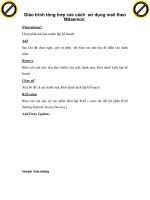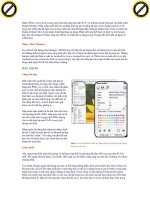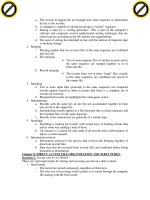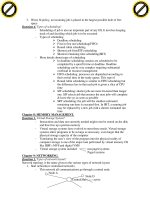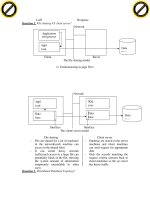Giáo trình tổng hợp các cách sử dụng máy in laser một cách hiệu quả và tiết kiệm phần 5 ppsx
Bạn đang xem bản rút gọn của tài liệu. Xem và tải ngay bản đầy đủ của tài liệu tại đây (206.29 KB, 5 trang )
a. The records in logical file are brought into some sequence as determined
by key in the records.
b. A computer is capable of sorting record into a “nested” sequence.
c. Sorting is done by a “sorting generator”. This is part of the computer’s
software and comprises several sophisticated sorting techniques that are
called into use according to the file and the sort requirements.
d. The need of sorting has dimished in line with the demise of magnetic tape
as backing storage.
2. Merging
- Merging implies that two or more files in the same sequence are combined
into one file.
a. File merging
Two or more separate files of similar seconds and in
the same sequence are marged together so as to
form one file.
b. Record merging
The records from two or more “input” files, usually
in the same sequence, are combined one record in
the output file.
3. Matching
a. Two or more input files (generally in the same sequence) are compared
records against record in order to ensure that there is a complete set of
records for each key.
b. Masmatched records are highlighted for subsequent action
4. Summanizing
a. Records with the same key in one file are accumulated together to form
one record in the output file.
b. Summanizing usually applies to a file presorted into a certain sequence and
the resultant file is in the same sequence.
c. Records to be summarized are generally of a similar type.
5. Searching
a. Searching is looking for records with certain keys or holding certain data
and in some way making a note of these.
b. An instance is a search for and count of all records with a debt balance of
above a certain amount.
6. Information retrieval
a. Information retrieval is the process that involves the bringing together of
data from several files.
b. Data may also be extracted from several files and combined before being
presented as information.
Chapter 8: DIRECT ACCESS FILE ORGANIZATION AND STRUCTURES.
Question 1. Storage and Access Modes?
There are 3 principal modes for storing and accessing accords on a disk or drum:
1. Serial mode:
- The record are stored contigously regardless of their keys
- The sole way of accessing serial seconds is to search through the complete
file starting with the first record.
Click to buy NOW!
P
D
F
-
X
C
h
a
n
g
e
V
i
e
w
e
r
w
w
w
.
d
o
c
u
-
t
r
a
c
k
.
c
o
m
Click to buy NOW!
P
D
F
-
X
C
h
a
n
g
e
V
i
e
w
e
r
w
w
w
.
d
o
c
u
-
t
r
a
c
k
.
c
o
m
- It is sometimes possible to partition a serial files thus reducing the search
time by starting the search at the beginning of a known partition.
- A serial file is normally of a temporary nature awaiting sorting into a
useful sequence.
2. Sequential mode:
- direct access sequential mode normally involves accessing sequential a file
that is stored sequentially.
- sequential mode is often associated with a master file held in a certain
sequence and updated by a transaction file sorted into the same sequence.
3. Indexed_sequential/ selective_sequential mode
- Indexed_sequential is a mode of storage where by records are held
sequentially and accessed selectively.
- Groups of unrequired records are skipped past.
- Indexed sequential files may also be accessed haphazandly.
4. Random modes:
- Each record is stored in a location determind from the second’s key by
means of an add generation algorithm.
- The only erricient way to find a record is to use the algorithm
- Random mode is applicable to master files
Ads of random modes
No index is required thus saving storage space
It is a fast access method because little or no searching is
involved
Transaction do not need storing, thus saving time
New records are easily insertly into the random file
provided they are not excessive in number
Dis
The main problem with the random mode is in achieving a
uniform spread of records over the storage are allocated to
the file
Question 2. Direct Access Addressing?
- The key of record is used to identify by record
- The key of record also is used to decide its storage location(or address)
1. Self addressing:
- Self addressing is a straight forwards method because a record’s address is
equal to its key’s value
- The file is inevitably stored in key sequence
Ads of self addressing
It leads directly to the wanted record
No indexing or searching is required
The key itself need not necessarily be held within the stored
record- although it generally is
Dis
The storage space per second has to be the same
When records one missing, storage locations related to its
must be left empty
2. Self addressing with key conversion
Click to buy NOW!
P
D
F
-
X
C
h
a
n
g
e
V
i
e
w
e
r
w
w
w
.
d
o
c
u
-
t
r
a
c
k
.
c
o
m
Click to buy NOW!
P
D
F
-
X
C
h
a
n
g
e
V
i
e
w
e
r
w
w
w
.
d
o
c
u
-
t
r
a
c
k
.
c
o
m
- This method a basically similar to self addressing except that the key
required a little processing to turn it into the record’s address
- This leads to either a pricise address
3. Matrix addressing
- In somes case, it is necessary to find the add of a record held within a
multi dimensional matrix of record it’s called matrix addressing.
Question 3. Direct Access Searching?
- Where as addressing determines the location of a record by using
algorithmic methods, searching finds the record by scanning groups of
records, and index, or both.
- ]The simplest method is to examine every record a file until the required
record is found a shortcut is generally desiable.
1. Indexed sequential searching
- A cylinder index is created to hold the highest cylinder’s key
- Associated with each cylinder is a block index holding the highest key in
each block within that cylinder
- When searching for a record’s key in the index
The cylinder index is examined key_by_key until one is
found that is larger than or equal to the wanted key this
directs the search to the appropriate block index
The block index a similarly examined and the search
The block is searched record by record until the wanted
record is found
2. Binary searching( binary chopping )
- The key in the index to be binary search must be in sequence and form a
complete set
- The search starts at the midpoint of the index and then moves half way to
the left or right(down or up) depending upon whether are wanted key is
less than or greater than the midpoint key
- In pracice, the index is unlikely to as convenient as this example because it
is not always possible to exactly halve each sucessive move(complete
exact holvingis possible only when the total number of keys in the index is
2
0
-1)
- The average number of examinations comparisons is (log
2
k)
-1
( k is the
number of keys in the index)
3. Block searching
- A block is a subdivision of an index. A block is devised to contain,
roughly the square root of the number of keys in the whole index
- The search is first through the block index to find the appropriate block
and then through this to find the wanted key
- The average number of examinations is square – root –
k
(k is the total
number of keys)
4. Balanced binary tree searching
- A binary tree is a relationship of keys such that the examination of any key
leads to one of two other keys
- The binary tree is actually in the form of an index containing all the keys
together with a directory showing the braches stemming left and right from
each key
Click to buy NOW!
P
D
F
-
X
C
h
a
n
g
e
V
i
e
w
e
r
w
w
w
.
d
o
c
u
-
t
r
a
c
k
.
c
o
m
Click to buy NOW!
P
D
F
-
X
C
h
a
n
g
e
V
i
e
w
e
r
w
w
w
.
d
o
c
u
-
t
r
a
c
k
.
c
o
m
- Binary tree searching is suitable for an unsequenced file
- The search is similar to binary searching in that each key examination
holves the rinaining keys, on average
Chapter 11: INTRODUCTION TO ARTIFICAL INTELLIGENCE.
Question 1. AI?
Atificial Intelligence
It has three braches
1. Expert systems (or knowledge- base system)
- ESs are programs that contain the knowledge of human expert, encoded so
a computer can understand it with encated- knowledge seasoning
machinism, ES can tackle problem that are beyond the seach of
conventionally programmed computers.
2. Natural language systems (everyday native language)
- Natural language systems are programs that understand the native
language of the user, such as E
- The most popular natural language systems are those that act as interfaces
to data bases
3. Simple perception systems (for vision, speed and touch)
- They can interpret visual scenes and decide if object meet inspection
standards and quality control criteria, or move a robot to the proper
location ot grasp a part for manufacturing
Question 2. Who does the updates?
- Updating the knowledge bases is very diffirent when with updating
databases because of the difference in the type of information and in the
cause and effect relationship contained in knowledge bases
- A knowledge in the area, when databases may be modified by a normal
users
Chapter 12: EXPERT SYSTEMS.
Question 1. What is an ES( Expert system )?
An ES is a knowledge-intersive program that solves a problem that normally requires
human expertise
Characteristics of ESs
- They solve problems as well as or better than human experts
- They use knowledge in the form of rules or frames
- They can consider multiple hypotheses simultaneouly
Types of ES
- An assistant
Is the leasts expert or lowest level ESs
It helps a decision maker by doing routine analysis and
porting out those portion of the work where human
expertise is required
- A colleage
The new discusses the problem until a joint decission is
reached
When system is going wrong, the user adds more
information to get it back on track
- True ES
Click to buy NOW!
P
D
F
-
X
C
h
a
n
g
e
V
i
e
w
e
r
w
w
w
.
d
o
c
u
-
t
r
a
c
k
.
c
o
m
Click to buy NOW!
P
D
F
-
X
C
h
a
n
g
e
V
i
e
w
e
r
w
w
w
.
d
o
c
u
-
t
r
a
c
k
.
c
o
m
Is a system that advises the user without question
There are no practical areas today in which decission
Question 2. A ES Life Cycle (ESLC)?
- An accepted SDLC for expert systems has yet to be developed
There are 6 phases life cycle in an ES
1. Phase1 – Selection of an Appropriate Problem
- Phase 1 involves finding an appropriate problem for an ES, indentifying an
expert to contribute the expertise
- Establishing a preliminary approach
- Analysing the cost and benefitsPreparing a development plan
2. Phase 2 – Development of a prototype system
- A prototype sys is a small version of an ES designed to test assumptions
about how to encode the facts, the relationships and the knowledge of
experts
- The prototype permits the knowledge engineer to gain the expert’s
commitment and to develop a deeper understanding of the field of
expertise
- Other subtasks in this phase:
Learning about the domain and the task
Specifying performance criteria
Selecting an ES building tool
Developing an implementation plan
Developing a detailed design for a complete system
3. Phase 3 – Development of a Complete System
- The main work in this phase is the addition of a very large number of rules
- The knowledge base has to be expanded to full knowledge base
appropriate to the real world and the user interface has to be developed
4. Phase 4 – Evaluation of the system
- This phase involves testing the system against the performance establised
in earlier stages
5. Phase 5 – Intergration of the system
- The ES has to be intergrated into the data flow and work patterns of the
organization
- In this stage, the expert system has to be interfaced with other databases,
instruments and hardware.
6. Phase 6 – Maintenance of the system
- The maintenance of the ES involves is updating, charging in the system
when operating. When operating, more problems occur in the system, so it
is necessary to continue take care the system by expert in a fix period of
time
- So expert system, are so complex that in a few year the maintenance costs
will equal the development costs.
BOOK II: Computer systems architecture.
Chapter 1 – 2: NUMBER BASES.
Question 1. Common number bases used in computer hardware operation?
Decimal(denary) system:
Click to buy NOW!
P
D
F
-
X
C
h
a
n
g
e
V
i
e
w
e
r
w
w
w
.
d
o
c
u
-
t
r
a
c
k
.
c
o
m
Click to buy NOW!
P
D
F
-
X
C
h
a
n
g
e
V
i
e
w
e
r
w
w
w
.
d
o
c
u
-
t
r
a
c
k
.
c
o
m
